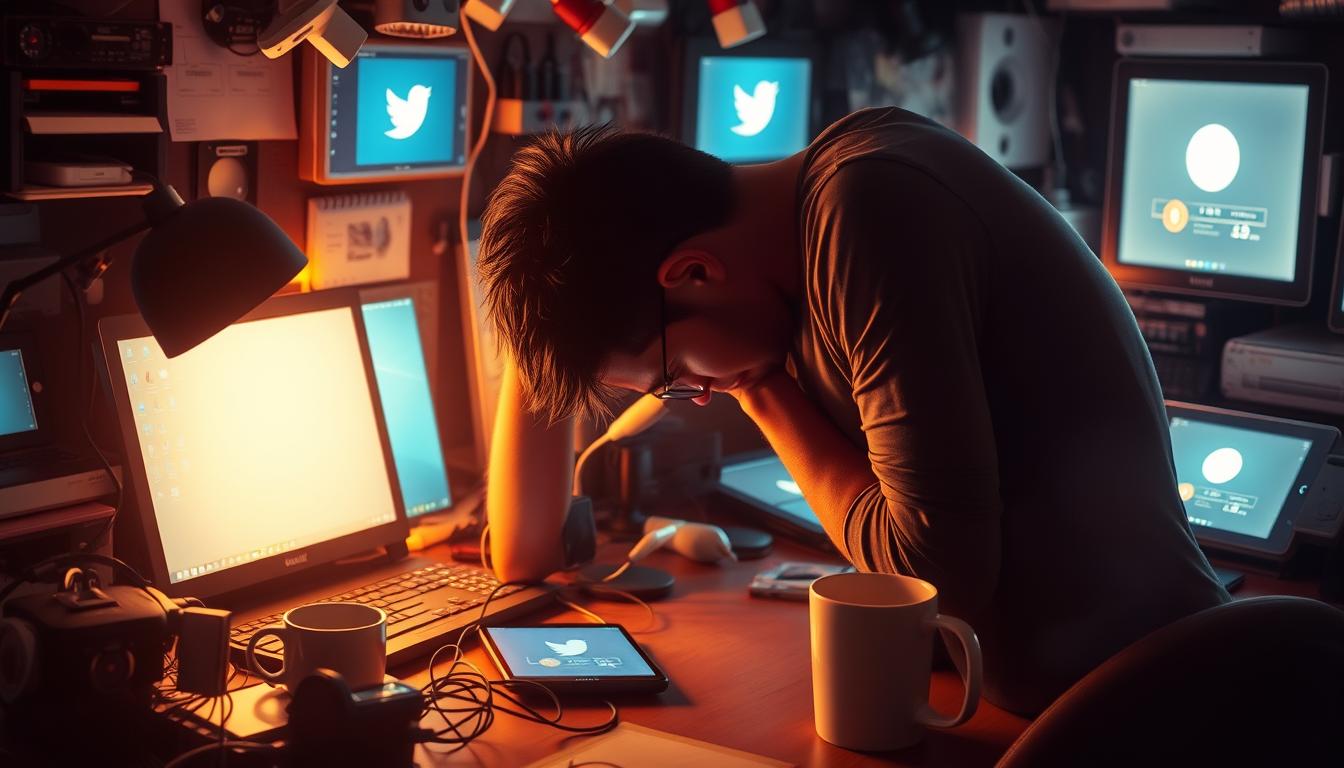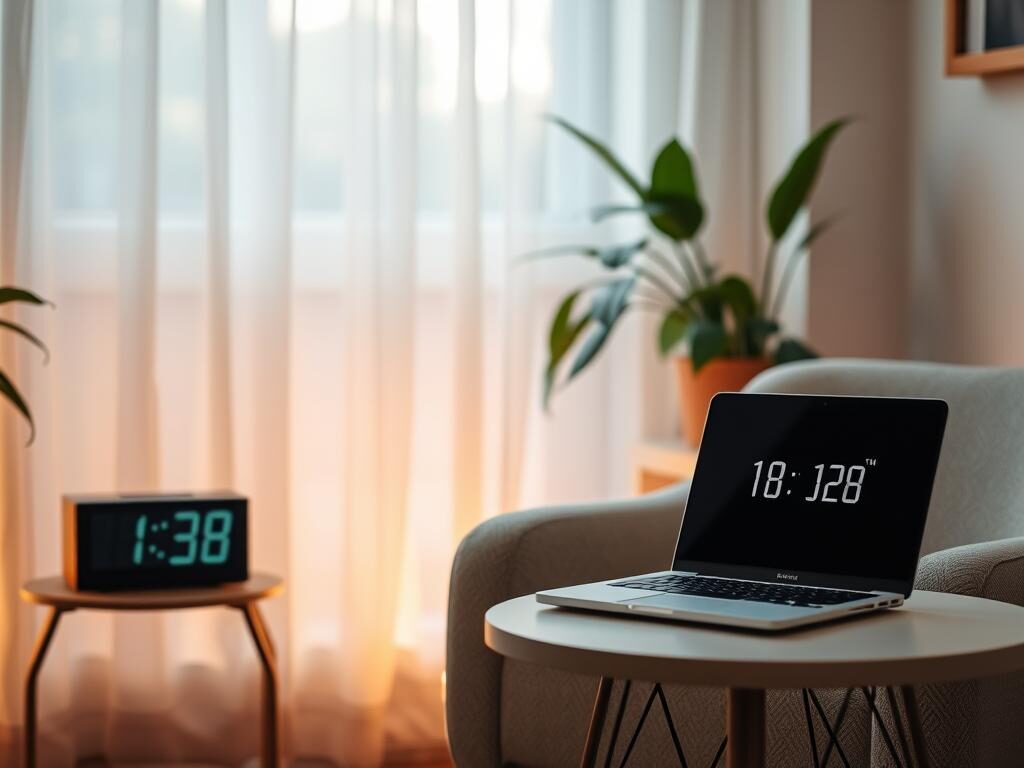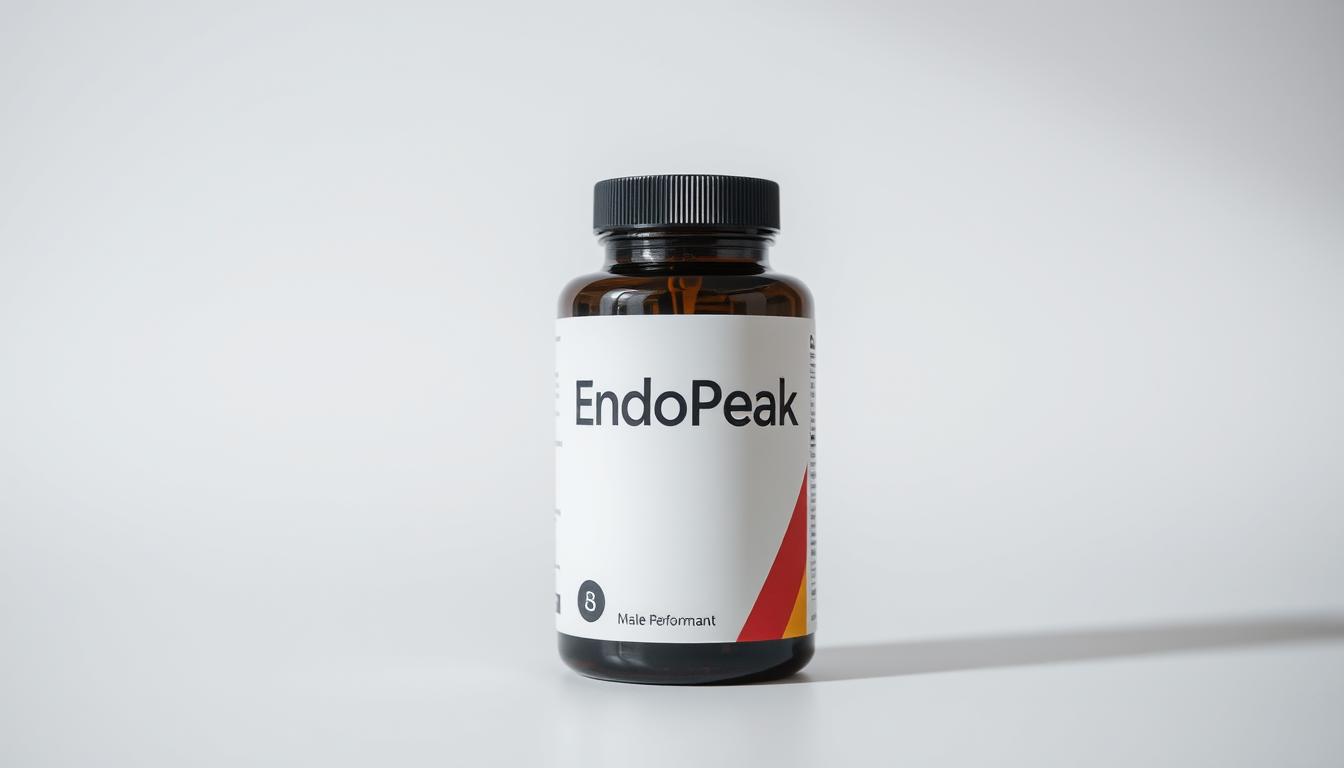
Daily scrolling and endless notifications make our online world fast-paced. Many feel both wired and tired from digital exhaustion and social media. Messages, posts, and alerts flood our devices, making it hard to disconnect.
Feeling the need to stay online to not miss out adds stress. This constant engagement can lead to mental overload. Digital exhaustion and social media use are now big parts of our lives, sparking talks about finding balance.
Key Takeaways
- Too much screen time may affect mood.
- Frequent updates can add to mental fatigue.
- Fear of missing out often drives online activity.
- Improving digital balance can ease stress.
- Monitoring habits fosters healthier usage.
Understanding the Rise of Digital Exhaustion
Being online all the time has led to a lot of fatigue. People are always checking their devices for work, social media, and updates. This constant checking can cause a lot of stress, especially if someone gets too caught up in social media.
The Role of Constant Connectivity
It’s hard to stop using devices, even when we need a break. Alerts and notifications keep us busy, always looking for the next message. This makes it hard to relax and can make our minds feel scattered.
Recognizing the Signs of Internet Fatigue
Some people find it hard to focus on things not online or feel anxious without their phone. Feeling down or irritable can happen if we miss out on updates. Spotting these signs early can help avoid bigger problems with social media addiction.
| Common Triggers | Possible Reactions |
|---|---|
| Non-stop alerts | Increased worry |
| Immediate response pressure | Difficulty relaxing |
| Endless scrolling | Mental exhaustion |
The Psychological Impact of Social Media Overuse
Too much time on social media can change how we live. People stuck on trending videos or tweets feel stressed. Feeling overwhelmed and tired is common when notifications never stop.
Anxiety, FOMO, and Emotional Well-Being
Feeling anxious is common when we’re always online. Worrying about missing out (FOMO) can make us doubt ourselves. Studies show that comparing ourselves to others online can upset our emotional balance.
“Online comparison can magnify insecurities, prompting users to question their own achievements and self-worth.”
Strategies for Maintaining Healthy Online Relationships
It’s important to keep our online friendships healthy. Real conversations and respect build trust and happiness.
- Set intentional boundaries by having tech-free times to reduce stress.
- Join forums where kindness and understanding are key.
Being aware of what triggers digital burnout helps us stay emotionally stable.
Digital Exhaustion and Social Media Use
Many people feel the need to keep up with endless scrolling and notifications. Each ping makes us check messages, respond to updates, or look at trending feeds. This cycle can drain our mental energy, causing internet fatigue for all users.
Stressful interactions happen when apps reward constant engagement. Views, likes, and comments give us short bursts of excitement that quickly fade. This leads us to keep searching for more satisfaction. When we lose track of time spent on social media, stress increases.
- Revisiting that feed before bed
- Shifting between multiple brand pages
- Reading stressful group chats
| Social Media Feature | Potential Stressor |
|---|---|
| Endless Feed Refresh | Extended late-night browsing |
| Notifications and Alerts | Frequent urges to respond |
| Multiple Profiles | Constant switching and updates |
How Screen Time Moderation Can Improve Well-Being
Controlling device use builds resilience and calms the mind. Simple actions like turning off alerts or deleting unused apps lessen mental stress. They help achieve a better balance between online and real-life activities.
Smart choices in screen time moderation protect emotional stability. They let people focus on activities outside the digital world.
Practical Time Limit Techniques
Smartphones have settings to track daily use. App timers block access after a set limit, stopping endless scrolling. Focus modes or third-party tools block notifications for a while. Reminders encourage taking breaks and forming lasting habits.
“Short disconnection intervals can refresh the mind and lift productivity,” experts at Mayo Clinic advise.
Creating Device-Free Spaces
Designating areas like the dinner table or bedroom as off-limits keeps peace. It encourages face-to-face talks and creative thinking without digital distractions. Tech-free areas in shared spaces boost focus, reduce stress, and strengthen connections.
| Method | Description |
|---|---|
| App Timers | Set daily caps on frequently used apps |
| Notification Pauses | Silence alerts to support concentrated tasks |
Recognizing Symptoms of Social Media Addiction
It’s easy to overlook signs when online use becomes too much. Some people can’t stop checking their phones, losing track of time. This focus on screens can hurt real-life relationships.
Too much screen time can cause online overstimulation. It messes with sleep and makes it hard to focus. Feeling stressed because of likes and comments can also harm emotional health. Using apps for validation or to escape problems is especially risky.
Spotting addictive behaviors means looking for different signs. These include feeling the need to check notifications all the time, getting anxious without a phone, and ignoring work or family. Recognizing these signs is the first step to getting help and finding balance again.
Digital Detox Methods for Reducing Online Overstimulation
A digital detox helps clear your mind by taking breaks from devices. These breaks let your mind rest and reduce stress from the internet. They help you form better habits online and improve your overall well-being.

Setting times for offline activities helps control screen time. Small steps like turning off alerts or eating without devices make a big difference. These habits lower stress and help you understand how you use technology.
Scheduled Breaks to Prevent Digital Burnout
Short breaks between tasks give your brain a chance to rest. Activities like journaling or reading can help reduce stress. These breaks give you time for reflection, hobbies, and real-life connections.
Using Technology for Wellness Instead of Stress
Mindful apps can help you relax if used with care. Apps like Headspace or Calm offer meditation, and Fitbit encourages healthy habits. This shows how technology can be used for wellness, not just stress.
| Method | Benefit | Recommended App |
|---|---|---|
| Guided Meditation | Sparks relaxation | Headspace |
| Gratitude Journaling | Encourages positivity | Day One |
| Fitness Reminders | Supports regular movement | Fitbit |
Balancing Connectivity and Offline Activities
Stepping away from screens can be a big relief. Offline hobbies spark creativity and strengthen real-world bonds. A digital detox can inspire new interests like painting, sports, or volunteering.
Time away from constant notifications helps deepen friendships and personal growth. Scheduling offline moments can lift stress and renew focus. Weekend adventures with friends add excitement.
- Learn a new painting technique
- Practice group sports or dance sessions
- Offer volunteer hours for social causes
Bill Gates once said, “I read a lot. It’s one of the chief ways that I learn.”
| Offline Activity | Description | Main Benefit |
|---|---|---|
| Painting | Express creativity through color | Reduced stress |
| Sports | Promote teamwork and physical health | Increased energy |
| Volunteering | Build community connections | Sense of purpose |
Adaptation Strategies for Managing Digital Burnout
The modern world is filled with notifications and constant connection. Finding a balance between online life and real rest is crucial. Each break is a chance to think about how social media affects us, making sure it enhances our lives, not controls it.
Building Personal Routines for Screen Time Management
Setting a schedule helps save energy. Simple steps like turning off non-essential apps or having a tech-free hour can help. These breaks let us recharge, improving focus and mental health. A regular routine helps us stay present and avoid endless scrolling.
Setting Healthy Boundaries in the Workplace
Disconnecting after work hours is key to personal time. Clear messages to colleagues can signal when to stop checking emails or chats. Taking breaks reduces stress, giving us time to recover from digital overload. Setting limits helps maintain a good work-life balance without losing productivity.
Long-Term Effects of Excessive Social Media Usage
Using digital platforms all day can be tough on your mind. It makes your thoughts jumbled and hard to focus. Also, constant updates and notifications make it hard to stay present.

Cognitive Overload and Memory Clarity
Too much information can make it hard to remember important things. Fast scrolling and endless content can hurt your memory. Stanford researchers say managing screen time helps keep your mind clear and focused.
The Importance of Regular Digital Breaks
Taking a break from screens can refresh your mind. It helps you feel more energized and less stressed. Short walks or reading offline can keep your thoughts sharp and balanced.
Here’s how to stay focused:
- Schedule device-free windows throughout your day
- Limit overnight phone usage
- Practice mindful pauses from technology
Managing screen time needs constant attention. Here are some benefits:
| Break Duration | Potential Benefit |
|---|---|
| 5-Minute Pause | Refreshing Concentration |
| 30-Minute Gap | Reduced Stress Levels |
Fostering Healthier Relationships with Technology
Using devices with a clear purpose and limits is beneficial. This approach helps maintain balance. It allows for learning and teamwork without feeling overwhelmed. Apps that promote growth keep us productive and at peace.
Our choices greatly impact our digital well-being. Some use tools like Apple’s Screen Time or Google’s Digital Wellbeing. Others limit notifications to focus on real-life connections. This thoughtful management reduces stress and boosts engagement.
“We expect more from technology and less from each other.” – Sherry Turkle
- Reflect on your online habits before opening each app
- Adopt mindful routines that keep digital interactions purposeful
- Seek quality content geared toward long-term enrichment
| Method | Benefit | Example |
|---|---|---|
| Curated Content | Enriched Mindset | Follow educational podcasts |
| App Selection | Positive Interaction | Opt for collaborative platforms |
| Notification Control | Stress Reduction | Silence alerts for set periods |
Practical Tips for Monitoring Online Habits
Thinking about how much time we spend online can help us understand our habits. This knowledge helps us make better choices and find a balance. People who keep track of their screen time often notice how it affects their energy and mood.
Looking at data on how much time we spend on certain apps can be eye-opening. Seeing graphs or charts can lead to quick changes to reduce distractions.
Leveraging Tracking Apps and Analytics
Apps like Apple Screen Time or Google Digital Wellbeing track how long we use our devices. They also send reminders to help us stay focused. These tools show us when we’re most stressed. Here are a few tips:
- Look at weekly reports to see trends
- Set daily limits to take breaks
- Turn off non-essential notifications
Daily Check-Ins to Gauge Technology Wellness
Short breaks during the day help us check our mental state. A reminder on our phone can ask us if we’re feeling balanced. These simple checks help us build better habits and change our priorities for a healthier digital life.
Conclusion
Smart choices about social media can protect our mental health and prevent digital exhaustion. Taking short breaks and creating device-free zones helps save energy. Time-blocking also helps us have healthier routines.
Platforms like Instagram or Facebook are great for staying in touch. But, it’s important to use them in moderation. If we feel anxious or tired, it’s time to take care of ourselves.
It’s good to pay attention to our daily habits and how much time we spend on screens. This helps us focus on real connections instead of endless scrolling. Taking a break or trying a new hobby can spark creativity.
By being aware and making small changes, we can find balance. We can use technology in a way that helps us grow. This approach makes technology a positive force in our lives.





